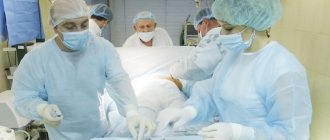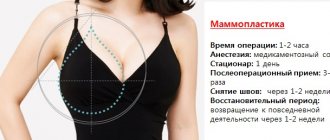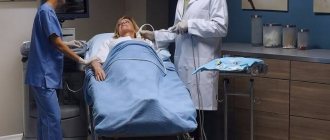Ptosis is diagnosed visually. The criterion is not volume and firmness, but the shape of the breast and the location of the nipple-areolar complex. Moreover, experts distinguish two forms:
- ptosis. Destructive changes in the mammary gland, causing the nipple to descend below the inframammary fold (submammary groove);
- pseudoptosis. With it, the areolar zone is located on the anterior part, but there is a prolapse of the lower segment of the mammary gland, covering the inframammary groove.
In the diagram, the blue line indicates the inframammary groove.
Then, from left to right: ideal breast, 1st degree ptosis, 2nd degree ptosis, 3rd degree ptosis and pseudoptosis.
Causes of breast ptosis
The volume and appearance of a woman’s bust is determined by: the condition of the pectoralis major muscle and ligaments, the ratio of fatty and glandular tissue formed into lobules.
- Age-related changes - over time, after about 45 years, the process of fibro-fatty involution of the mammary glands begins in a woman’s body. It consists in the degradation of glandular tissue and its gradual replacement with adipose tissue. This occurs against the background of hormonal changes, which are especially active during menopause. These changes lead to a deficiency of the sex hormones estrogen and the gradual “fading” of the body. The synthesis of collagen and elastane, which are structural components of connective tissue, dermis and ligaments, slows down. As a result of fibrofatty involution, a woman’s breasts lose their aesthetically attractive appearance and, under the influence of the natural gravitational forces of the Earth, droop.
- Hereditary factor - congenital features of the synthesis of collagen and elastin determine the rate of tissue aging and predisposition to gigantomastia, and therefore to mastoptosis.
- Pregnancy and breastfeeding - during pregnancy, a woman’s breasts increase in volume due to the filling of the glandular lobules with milk. At the same time, the load on the ligaments increases, and the skin stretches. After completion of lactation, the volume of the gland gradually decreases. Due to stretching of the skin, the breasts look “empty” and saggy. In addition, uneven distribution of milk, as well as feeding a baby from one breast, can lead to noticeable asymmetry.
- Rapid weight loss or weight gain - fatty tissue not only actually determines the shape of the mammary glands. In case of rapid weight loss, part of the breast volume is lost, and the skin does not have time to recover. Adipocytes in adipose tissue store and synthesize hormones that are responsible for metabolism. On the contrary, rapid weight gain leads to an increase in the volume of the mammary glands and stretching of the skin.
- Endoprosthetics of the mammary glands with implants that are too large - breast ptosis after mammoplasty occurs the faster, the larger the prosthesis and the less elastic the skin.
- Smoking and alcohol abuse.
How to effectively tighten sagging breasts in women at home
The problem of sagging breasts affects women of all ages. Preventing bust sagging is difficult, as the reasons are very different. Today, there are many special techniques for lifting sagging breasts, operations, and it is also important to make lifestyle adjustments. It has been proven that regular performance of special exercises can tone the chest muscles and strengthen the décolleté area.
- 1 Causes of sagging
- 2 Symptoms of breast drooping
- 3 Ways to slow down breast sagging 3.1 Exercises for the pectoral muscles 3.1.1 Push-ups
- 3.1.2 Yoga
- 3.1.3 Palm compression
- 3.1.4 Lifting the load
Gradual downward displacement of the breasts (ptosis) is most often a consequence of natural aging of the skin. Less common causes are poor lifestyle choices and external influences on the skin. In any case, ptosis is caused by a loss of elasticity of the breast tissue.
Sagging breasts affect a woman's life both physically and psychologically. The severity and degree of sagging of the bust is assessed depending on the position of the nipple in relation to the facial fold, where the underside of the breast contacts the chest wall.
The sagging process begins with the loss of fatty tissue, which leads to a decrease in breast size and fullness. There is a noticeable change in the position of the areola in the lower part of the bust. Estrogen is important for maintaining the structure of the ligaments and connective tissues in the female breast. With aging, estrogen levels drop, which leads to a gradual sagging of the bust.
The most common causes of sagging breasts are:
| Cause | Description |
| Genetics | A woman's heredity greatly influences the degree of sagging of the bust - plays an important role in determining the strength of the ligaments and the elasticity of the skin |
| Size | Due to their heaviness, large breasts stretch significantly. A heavier bust will tend to sink to the floor, so it is necessary to constantly support it with a suitable bra |
| Weight loss | When the volume of the body decreases significantly and sharply, fat is burned in the chest, forming empty space. After losing weight, the skin and ligaments do not tighten back on their own, in which case breast sagging is inevitable |
| Pregnancy | The most common reason for breast drooping in this case is lack of breastfeeding. As a result, breast tissue may shrink and lose its elasticity. |
| Smoking | Tobacco smoke contains free radicals, which are responsible for damaging skin cells and causing loss of elasticity. |
| Menopause | During menopause, the glands and ducts in the chest shrink because they are no longer needed to produce milk. |
| Wearing a bra | There is a common misconception that wearing supportive underwear prevents breast sagging. In fact, the ligaments responsible for supporting the breasts can become thinner and weaker when wearing a bra all the time. |
There are cases of breast prolapse during adolescence. The reason for this is too large breast size, frequent exercise with weights and weight problems. At a young age, the skin is still full of elastin and collagen, so stretching is treated more effectively and the result will be noticeable even with little care.
After 30 years, women's breasts gradually begin to lose fatty tissue, which leads to a decrease in their size and fullness. One of the first symptoms of a sagging bust is a noticeable downward shift of the areola. As we age, the amount of estrogen decreases, which negatively affects skin elasticity.
To diagnose sagging, doctors use a ptosis scale. It helps to assess the level of the problem and prescribe treatment. Among the main types of pathology:
- 1. Mild ptosis - the nipple is in its place.
- 2. Moderate - the nipple is located below the subframe fold, the lower breast tissue hangs below the nipple.
- 3. Advanced - the nipple is located below the subframe fold and at the level of the maximum projection of the breast.
- 4. Heavy - the nipple is located significantly below the pectoral fold and at the level of the maximum projection of the breast.
It is impossible to prevent all causes of sagging breasts, but every woman can control the influence of other factors, such as smoking and sudden weight gain.
It is important to avoid diets that cause weight fluctuations; extreme weight loss in a short period of time is especially harmful. If you're overweight, you should stick to a gradual fat loss plan that includes eating right and regular exercise.
With constant running, women with large breasts are at risk of stretching their bust. To avoid this, you must wear a sports bra while exercising.
According to some studies, sagging breasts can be treated with implants. However, additional tightening procedures may be required after surgery.
There are certain ways to slow down the process of breast sagging that do not require surgery:
| Way | Recommendations |
| Lactation | After weaning a baby from breastfeeding, the milk stagnates and begins to stretch the skin. The baby also stretches the tissue when he pulls on the nipple. As a preventative measure, it is advisable to reconsider your feeding method. When breastfeeding correctly, the baby is positioned so that he can suckle from the side and not from the bottom. |
| Massage | Regular massage in the décolleté area helps increase blood circulation in the tissues. This increases blood flow with a supply of fresh oxygen to saturate muscles and tissues. This increases the production of collagen, which is indispensable for problems with insufficient skin elasticity. To enhance the effect, use special oils and gels |
| Replacing old bras | Even the best quality bras are suitable for wear no longer than 6-9 months. The cups and band size stretch with time and the weight of the breasts. The material of the bra is weakened by washing. It is recommended to hand wash bras in cold water and avoid drying them in a hot dryer. |
| Hydration | Dry and dehydrated skin is weaker and more at risk of stretching. Therefore, it is necessary to smear the décolleté area with oils and firming creams. It is advisable to choose beauty products that contain ingredients to boost collagen production - holy basil or echinacea |
| Exercises | The tissue in the breast consists mainly of fat, milk ducts, connective tissue, blood vessels and lymph nodes. The breasts themselves do not contain muscle tissue. Therefore, exercises cannot help tighten it. But the breasts are attached to the pectoral muscles, which, with regular use, begin to increase and thereby tighten the upper part of the bust. Thanks to special exercises, your arms and back are strengthened and the appearance of your bust is improved. Push-ups and yoga are considered the most effective ways to tighten your chest. |
| Posture alignment | You can visually tighten your bust simply by straightening your shoulders. Correct posture is beneficial not only for improving the appearance of the bust, but also for tightening the abdomen, correcting stoop, improving digestion and relieving back pain |
No home method can keep a bust forever, but it will prolong its youth and beauty for several more years. Cosmetic breast surgery is considered a last resort to solve the problem of sagging. The operation is performed by surgeons using silicone implants or without them. Although the option of not using implants is not as risky, silicone analogues look natural and feel similar to real breasts.
It is worth considering that the operation has certain risks associated with a decrease in nipple sensitivity, the formation of defects and infections at the incision site.
Stages of mastoptosis
According to the classification proposed by American plastic surgeons, there are 3 degrees of mastoptosis.
Breast ptosis of the 1st degree is the initial stage of breast ptosis, in which the nipple is at the level of the submammary (inframammary) fold or slightly lower.
Breast ptosis of the 2nd degree - the nipple falls less than 3 cm below the inframammary fold.
Breast ptosis of the 3rd degree - the nipple is located more than 3 cm below the level of the fold and looks down.
False ptosis (mastoptosis) is characterized by the normal position of the nipples and sagging of the lower pole of the mammary glands - it is located under the submammary fold.
Ideal breasts: formula of British scientists
The most correct, standard shape is considered to be the breast, the formula of which was developed by British scientists! Well, who would doubt it? What else can you do in Britain if not develop a formula for women's breasts?
So here it is. The formula is simple:
- mentally divide the bust with a line passing through the nipple into two parts. If the top and bottom have a proportion of 45% to 55%, then this is the ideal shape. Oh yes! The nipple should be raised by 20-45%.
If the proportions change and the nipple loses its angle, then different degrees of mammary gland ptosis or mastoptosis (prolapse) are determined depending on the position of the nipple relative to its ideal place.
To describe it briefly, the more the nipple faces the floor, the higher the degree of ptosis (mastoptosis).
Treatment of breast ptosis
With the help of physical exercise and diet, you can reduce the volume of fatty tissue, but this does not affect the condition of the connective and glandular tissue, which also gives the shape of the breast. In addition, with mastoptosis, the problem is also stretching of the skin.
On the contrary, breast lifting in the salon (mesotherapy, biorevitalization, massage and other cosmetic procedures) is aimed at improving the condition of connective tissue. These non-surgical methods require regular repetition and will not correct severe breast ptosis. Injections of vitamin complexes, hyaluronic acid and other active substances will help achieve a qualitative improvement in the condition of the skin, restoring the synthesis of collagen and elastane fibers. Cosmetic procedures can slow down the aging process and improve the appearance of the breasts, but they cannot correct breast ptosis or breast shape.
Why does the bust drop?
The elasticity of tissues decreases with age. Especially after hormonal disturbances (menopause). During menopause, age-related involution of the glands leads to the bust sagging.
The main factors pushing the mammary glands to prolapse are:
- extreme weight loss of 20 kg or more;
- large bra, too large cups;
- the most magnificent bust;
- obesity and metabolic (metabolic) disorders;
- smoking;
- a large number of pregnancies (regardless of whether you had an abortion or carried a child to term).
Interesting fact: both doctors and women themselves blame breastfeeding for the development of mastoptosis. A study by plastic surgeon B. Rinker from the University of Kentucky, completed in 2006, did not confirm the development of breast ptosis with breastfeeding (with proper latching of the baby to the breast and weaning from the nipple), with weight gain during pregnancy or regular strength exercises for the upper torso.
Another interesting fact: Do you like to run? Buy compensation underwear with a “pocket” for each gland (not compression, pressing the breasts to the body). Then your bust will fluctuate less when running and you will maintain its shape. Special underwear is needed regardless of bust size (previously it was recommended only for ladies with curvy figures).
How to correct ptosis with a surgical lift (mastopexy)
In case of breast ptosis of the 1st degree, the bust can be restored to its beautiful shape with the help of endoprosthetics - an operation to enlarge it with implants. The problem of more advanced ptosis of the 2nd or 3rd degree is solved by mastopexy (mammopexy), that is, a breast lift. The essence of this plastic surgery is the resection of excess skin, fat and glandular tissue, as a result of which it is possible to raise the nipple-areolar complex. If there is insufficient volume of breast tissue, mastopexy can be combined with endoprosthetics and thus increase breast size. If a woman has noticeable asymmetry, it can be eliminated by combining a lift with reduction mammoplasty or endoprosthetics. In general, mastopexy is performed under general anesthesia for 1-3 hours.
There are three main methods of breast lift:
Periareolar mastopexy
It is used to eliminate mild and uncomplicated ptosis of 1st or 2nd degree. The plastic surgeon makes an incision around the areola to remove excess skin.
Vertical mastopexy
The method is used for breast ptosis of 2 and 3 degrees. The plastic surgeon makes two incisions: one around the areola, and the other vertically downwards from the circumference by 7-8 cm.
Anchor (or “T-shaped”) mastopexy
The most effective way to eliminate advanced stage 3 breast ptosis. The technique involves a composition of three neat incisions: vertical, around the areola and along the contour of the inframammary fold.
Correction options
It is unrealistic to tighten your breasts without the intervention of a specialist. After all, muscles do not play a very important role in her condition. Even if you “pump up” them, this will not make the ligaments, glandular and connective tissue more elastic.
With the first degree of ptosis and small breasts, the introduction of threads can help restore their high position and elasticity. This lifting is performed on an outpatient basis, under local or intravenous anesthesia. It consists of placing absorbable or synthetic threads under the skin, 3-5 mm deep. They form a frame that supports the breasts. And around them there is an increased formation of collagen and elastin fibers. This gives a tightening effect for a period of 2 to 5 years or more.
But a more reliable correction of mammary gland ptosis is done using operations:
- Vertical mastopexy is indicated for moderate cases . During this procedure, an appropriate incision is made in the lower part of the breast, as well as around the areola. Through them, excess tissue is removed, the nipple is shaped and raised.
- Areolar mastopexy is indicated for the first degree of ptosis. It is performed by making an incision only near the areola.
- A T-shaped mastopexy will help correct maximum sagging. Incisions are made along the inframammary fold and in the lower part of the gland from the areola to the base.
The type of operation is selected according to the degree of ptosis. The maximum effect will last for 10 years.
Why should a breast lift be done at the clinic? N.I. Pirogov?
Our plastic surgeons know how to correct breast ptosis, giving it a beautiful and toned shape again without noticeable post-operative scars. Look at the portfolio of our specialists and you will be convinced of this. Since 1999, doctors of the clinic named after. N.I. Pirogov in St. Petersburg successfully perform all types of operations on the mammary gland: from endoprosthetics to reconstruction after mastectomy. If, after some time, you are faced with the problem of breast sagging after primary mammoplasty, our plastic surgeons will not only solve this problem, but will take care of high-quality and long-term preservation of the result. We offer our patients:
- services of the city's leading plastic surgeons;
- medical offices equipped with modern equipment at the level of European private clinics;
- stay in comfortable wards for 1-2 people with meals, nursing care and round-the-clock supervision by a doctor on duty;
- special promotional offers (all inclusive) at affordable prices;
- own laboratory, which allows you to quickly obtain accurate diagnostic results, and intensive care;
- cosmetology department services, which can be useful for the prevention and treatment of mild breast ptosis;
- organizational assistance from a supervisor for patients from other cities.
Prevention and treatment
Breast lift with surgery
Treatment of ptosis of the mammary glands without surgery is impossible. No homemade formulations, ointments, lotions, compresses, etc. will not help solve the problem.
Only aesthetic breast surgery can change this situation. In plastic surgery, this is the most popular procedure. The essence of the surgical intervention is to remove excess fatty tissue, tighten the skin, or change the size and shape using implants. After the operation, women note that the scars are almost invisible. If necessary, the nipple and areola can be moved to the desired location.
Pregnancy is a contraindication to surgery
The procedure has a list of contraindications:
- blood clotting disorder;
- pregnancy and lactation;
- the course of mastopathy and other diseases of the mammary glands;
- pregnancy planning;
- disturbances in the functioning of the endocrine system;
- diabetes.
Surgery is not performed if there are large burn and/or postoperative scars on the skin.
The result of surgery to eliminate ptosis
At the stage of planning the operation, doctors should warn about the development of possible complications. They are divided into natural and pathological.
Natural complications include:
- swelling of the soft tissues, which disappears after 3-5 days (in some cases, drugs are prescribed to relieve inflammation and swelling);
- painful sensations bother patients for 2-3 weeks after surgery (doctors prescribe painkillers);
- decreased breast sensitivity and scar formation.
Pathological complications:
- a poor result can be contemplated as a result of insufficient professionalism of the plastic surgeon or due to the individual characteristics of the patient’s body;
- the formation of fistulas - holes in the skin that form due to a purulent process;
- suture dehiscence can also be observed due to insufficient professionalism of the specialist, or the patient’s failure to comply with the rules of the recovery period;
- the formation of large bruises and hematomas, which must be removed surgically.
If after correction a woman gains and loses weight dramatically or decides to give birth, another operation may be required in the future.
To prevent ptosis, you need to give up bad habits
Ptosis of the mammary glands is an inevitable phenomenon. However, a certain set of measures will help slow down this process:
- to refuse from bad habits;
- regularly use high-quality cosmetics with the most natural composition;
- monitor the state of hormonal levels and adjust them if necessary;
- do massages;
- exercise;
- take a contrast shower daily;
- take multivitamin complexes in courses.
By following all the recommendations listed, you will be able to keep your mammary glands firm and beautiful for a long time without the help of plastic surgery.
Laser therapy
Unlike traditional surgery, laser therapy is non-traumatic. During the procedure, laser radiation is used, which has a beneficial effect on the dilation of blood vessels, blood circulation, and stabilization of regeneration and metabolic processes.
Experts consider electrical stimulation of the muscles of the upper eyelid one of the most effective methods of treating ptosis. The procedure helps restore the primary functions of the eyelid muscles and the functioning of nerve endings in the visual organs. Electrical stimulation is also aimed at innervation of the muscle layer, bringing it into tone. All this helps eliminate the problem of drooping eyelid (only mild ptosis) without the need for surgical intervention.
Possible consequences and complications
At the initial stage of development of the pathology, a woman experiences discomfort due to a cosmetic defect, and, as a rule, self-esteem falls. As ptosis progresses, other complications are added:
- the formation of cysts, which, under favorable conditions, develop into malignant neoplasms;
- diaper rash;
- erysipelas; inflammatory formations;
- circulatory disorders;
- disruption of lymph flow.
Due to impaired blood circulation, the layers of the epidermis do not receive the optimal amount of nutrients, so the skin loses its firmness and elasticity.
{SOURCE}











